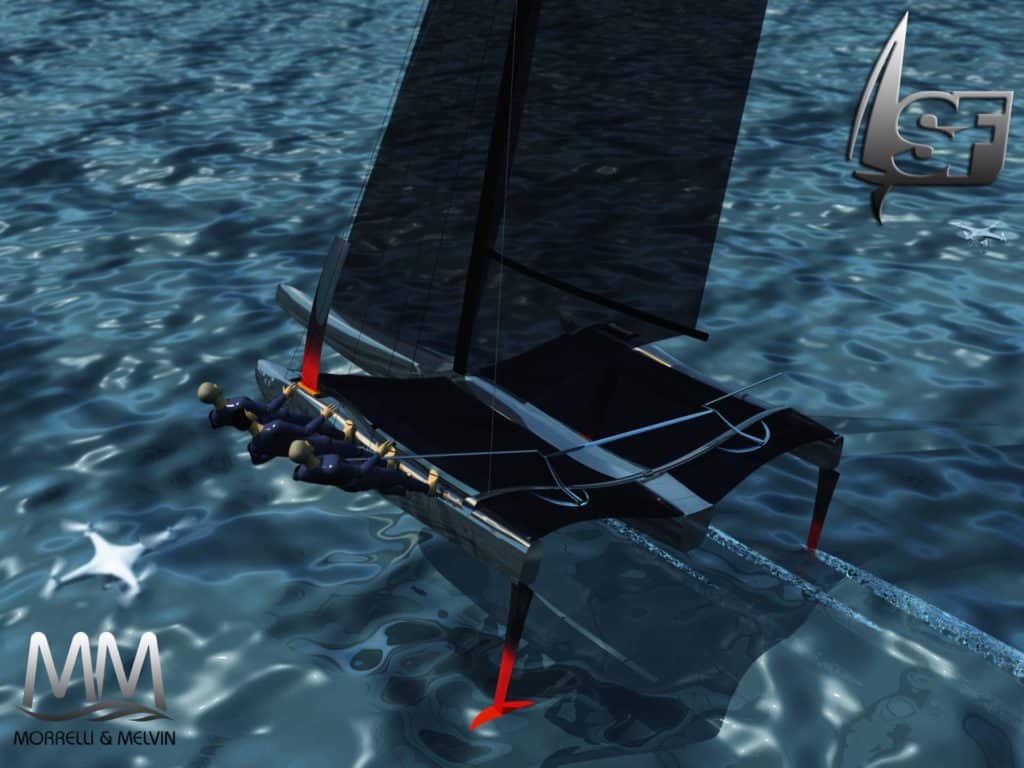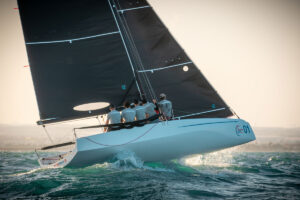● Twenty-five years ago, during my annual lecture tour, I made a few outrageous predictions about innovations in sailing. When I reflect on that list today, I’m surprised by how many of these outlandish ideas have become reality. For example, I thought someday we’d be able to use GPS technology to determine whether a boat was over the starting line, that a boat would exceed 50 knots, and that someone would sail around the world in less than 60 days. Of course, we now know that technology developed for the America’s Cup can determine when a boat is over the line (and doing so while the boat is reaching across at 20 knots, no less). In 2012, Paul Larsen’s Vestas Sailrocket 2, flew across a 500-meter stretch of Walvis Bay in Namibia at 65.45 knots. In late 2016, Francis Joyon’s IDEC 2 completed an amazing circumnavigation in 40 days, 23 hours.
Sixty days? Pshaw. I was way off. Without a doubt, the sport has evolved dramatically. But where does this leave us today, looking ever further into the future? As I did many years ago, I have a few ideas today.
Sailing administrators and naval architects have been forever searching for a fair handicap-rating system. There are several in use around the world, leaving potential and current boat owners easily confused as they try to decide what kind of boat to build or buy. With the use of supercomputers, we will achieve the unthinkable and launch a handicap rule that is reliable and fair for boats of all sizes. The system will be based on actual performance in all racing conditions. Here’s how: Every moment while racing, a boat’s performance will be recorded and analyzed against every other offshore boat in the world, in real time, and in every sea state and wind condition. Handicaps will be adjusted continually. Time on the racecourse will therefore be the key determination of success — not size, shape, displacement or modifications to the boat.
Today’s speed records will continue to fall as lightweight materials become stronger and control systems more refined. As a result, with the use of foils and high-efficiency aerodynamic rigs, boats will sail at extraordinary speeds — let’s now put the target at 100 knots on the 500-meter course and 30 days for a circumnavigation.
Outrageous? I think not.
One-design classes will be built using three-dimensional printing for hulls, rigs and parts. Everything will be made to exact standards, and boats will all have equal potential. The reduced manpower will dramatically cut the cost of production, and pre-regatta measurements will be greatly reduced. Thirty years from now, there will be so many different one-design classes on the water that very few boats will race in each class. Regatta organizers will recognize this trend and establish a conference to discuss the problem. The decision will be made to declare that only four classes will be sanctioned as one-designs. Each will have a different size rig depending on the age and size of the sailors. The boats will be fast, strong and easy to right after capsize.
On the technology front, batteries will be able to hold an extended charge. Solar power integrated into the sails and deck, along with a new concept of using a yacht’s motion, will generate energy to keep batteries charged, eliminating entirely the need for fossil fuels.
Miniature drones will be launched while racing to project aerial images around a 1-mile perimeter of the boat’s position, which will assist with reading the wind.
Lidar readouts will display wind speed and direction ahead of a boat. Lidar uses tiny laser beams to measure the flow of dust particles in the air. Small-scale instruments at the top of the mast will account for the movement of the mast as a boat sails through the waves, and sensors on the luff of the sail will record apparent wind speed and indicate how sails should be trimmed according to wind shear, in real time and in the next few boatlengths.
Here’s one we can all get behind: Protest hearings will be a thing of the past. Images from small cameras with position data from each yacht involved in a dispute will be fed into a computer. The resulting calculations will determine who wins the protest. It will save a lot of tension usually found in the protest room, eliminate the cost and need for international judges on-site, and keep sailors from pushing the rules.

Rigs will favor single sail plans with wing structures. Masts will bend in concert with wind strength, and the boat will sail at peak efficiency at all times. Helmsmen will constantly be tested on their performance versus a computer’s predicted numbers. This technology is in use today, of course, but the difference will be the ability to monitor a sailor’s vital signs, and fatigue. When a helmsman starts to stray off-course, the instrument package will set off an alarm, or speak to the skipper through a small in-ear device. While self-driving cars will become commonplace on land, sailors like to steer, so rules will be in place to prohibit self-steering boats while racing (autopilots for shorthanded sailing excluded, of course). Seasickness will be a thing of the past too. One small pill will work for several days, with no side effects. Lighter, more-breathable foul-weather gear will keep you drier and warmer, and their fabrics will sense dehydration, alerting us when it becomes detrimental to performance. A personal beacon will keep track of our exact location if we fall into the water. An EPIRB is used today to send a location signal, but the new version will be a small, wearable and waterproof strip customized for each sailor.
Telephone service will be less expensive, thanks to laser-satellite technology that works anywhere in the world. It will be small and light. If there is a health issue offshore, a sailor’s health information will be relayed back to a small wearable device. An integrated screen will be on the chest of each piece of clothing.
Computational fluid dynamics will be used to design the precise sail, hull and keel shapes for a given weather condition. An expandable membrane on the exterior of the hull or skin will change shape to maximize performance. Anti-fouling agents will keep all organic growth off hulls, and the film will be environmentally clean. Sustainability will be a regular feature of every sailing regatta. The environmental success in the sport of sailing will inspire other sports to follow suit.
Social media will help owners recruit crew for racing. Skill level, physical size, capability and even compatibility will be part of the equation. Naval architects and engineers will come up with ever-faster designs using IBM’s powerful computer, Watson. We will learn that early naval architects such as Nathanael Herreshoff (who had no computer assistance) were well ahead of their time with their creations. I suspect we will be going back to older designs to understand what might provide something new. Imagine if Herreshoff, Clinton Crane or Olin Stephens had the use of supercomputers.
In a 1972 edition of this magazine, a Princeton sailing-team member Tad LaFountain wrote an article about the advent of professional sailing, saying that it was made for television. At the time, his vision seemed comical. Today, however, professional sailing is prevalent, but in the future, there will be a return to amateur sailing. Television broadcasts will fade away entirely in favor of online delivery. Every team will have the ability to showcase its own boat on the preferred social platform of the day.
As technology makes decision-making easier, the intuitive skills of a sailor will fade. To retain the human element in the sport, some sailing events will forbid any outside or technological assistance. The America’s Cup will be one of the first major sailing events to emphasize a sailor’s skill over computing power. The boats will be sailed without any instruments at all. The event will become so interesting that millions of viewers (on personal mobile devices) will watch with great interest. This raises one final consideration: How far should technology take us before we lose the fundamental attributes of sailing? That too is up for future discussion.
Find out more about the SuperFoiler project here.









